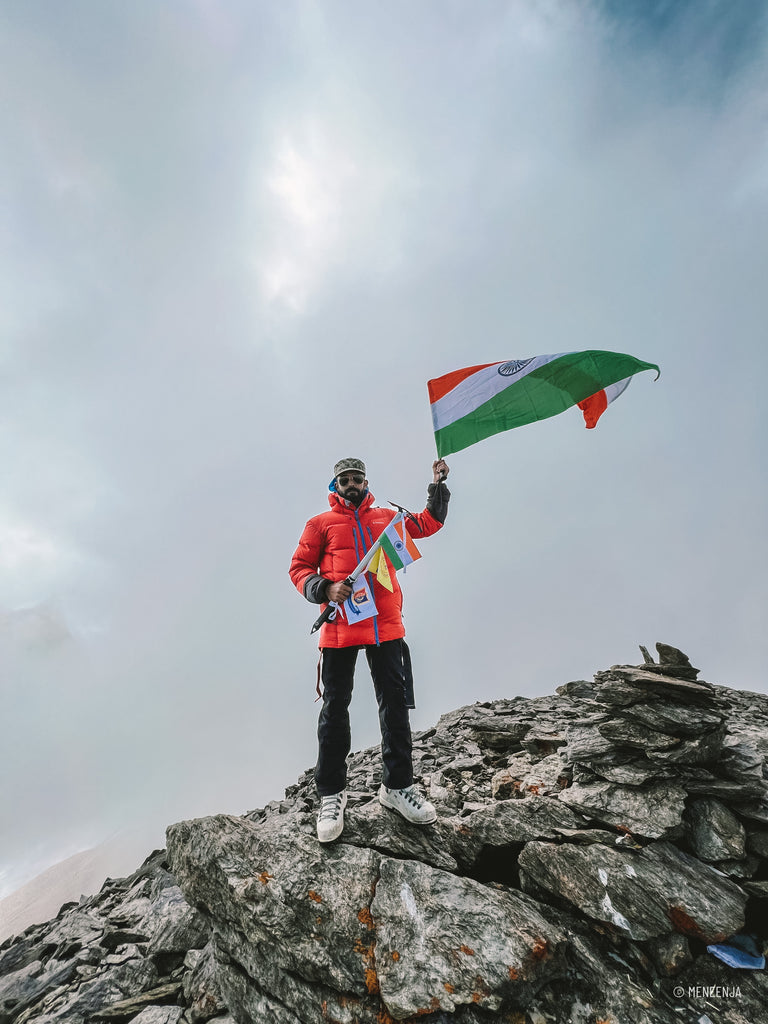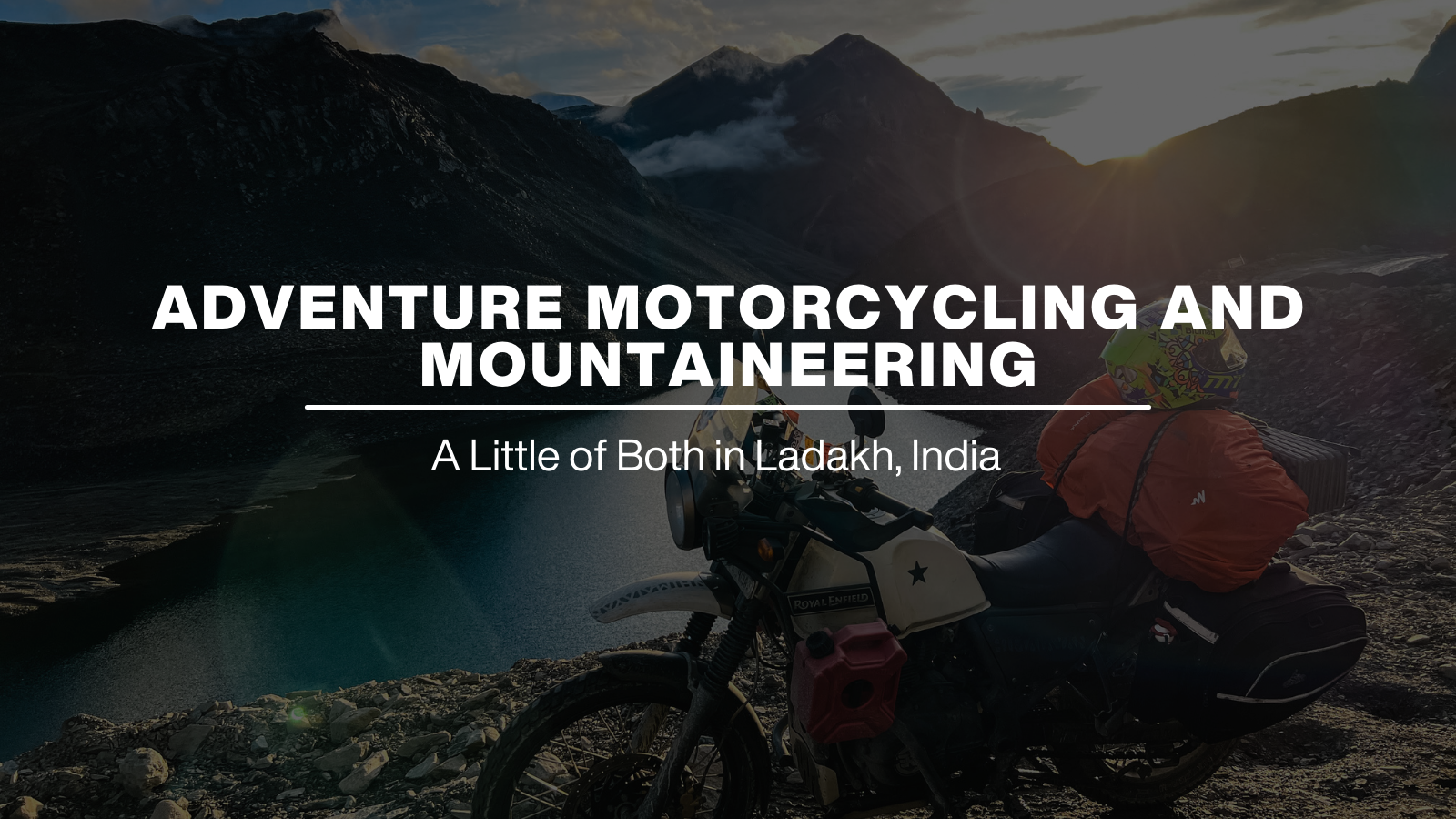I used to stare at the high mountains surrounding Ladakh, India, every time I rode my motorcycle there, wondering how it would be to combine motorcycling and mountaineering. I decided to put it to the test this time. A solo motorcycle ride to the roadhead which was a village in Ladakh, followed by my first mountaineering expedition to a virgin peak at a height of 6,081 metres.

Gearing up for the ride and the climb:
Because it was monsoon season, I had to take extra precautions when packing my bags for the ride because I didn't want any of my mountaineering equipment, particularly my down jacket and sleeping bag, to get wet. To keep everything dry in my bag, I wrapped it in sheets of plastic. My luggage consisted of a tent, a sleeping bag, a mattress, a down jacket, trekking pants, waterproof gloves, hats, trekking poles, butane gas cans and a burner, snow boots, crampons, a climbing harness and carabiners, sunglasses, a hat, and a head torch. Although I use the majority of these items for my rides, technical items such as the harness and carabiners were added to the overall gear on the motorcycle. My biggest mistake here was not carrying an extra pair of trekking boots because I was wearing my new waterproof boots for the ride, but the rain quickly got the boots wet and I regretted not carrying an extra pair to change into.
The motorcycling expedition:
A roadhead is the end of a motorable road from which one begins on foot or with the assistance of mules or porters.
I had to travel 1,000 kilometres from my home to the roadhead, 700 kilometres of which were completely mountainous terrain. Because it was raining heavily, causing landslides and roadblocks, I decided to divide my journey to the final destination into four days to avoid fatigue.
On Day 1, I left New Delhi on a sunny morning, only to be greeted by rain after 100 kilometres, which I rode in for two hours. I arrived at my friend’s place in Shimla completely soaked, but my luggage was safe and dry thanks to the plastic wraps. I stayed an extra day at his house to allow my belongings to dry before departing for Manali. The ride to Manali was relatively dry, and I avoided the landslide zone by taking a lesser-known detour. I met a few mountaineering friends in Manali in the evening and decided to ride along with them as they attempted Mt. Yunam, a non-technical peak of 6,111m in Himachal Pradesh's Lahaul district. The next morning, I left with my friends for Bharatpur Tent Colony, where we spent the night in the freezing cold inside a shared tent. It was a clear night and the stars shone brightly, but everyone was feeling the effects of high altitude because we'd climbed 2,700 metres in one day and reached an altitude of 4,700 metres.


Loss of appetite and dizziness with a heavy head are common symptoms in high altitude regions, but we all forced ourselves to eat well that night and drink plenty of water to allow our bodies to adjust to the altitude. The others were making their way towards the Yunam base camp, while I had to ride my motorcycle further down. We said our goodbyes the next morning, and I set off for Upshi, where I would meet up with the rest of the expedition team.
Riding through familiar Ladakh terrain, I arrived in Pang and stopped for lunch at my usual spot, after crossing the high mountain passes of Baralacha La and Nakee La, as well as the scenic Ghata Loops (with 21 hairpin bends). There, I was approached by another motorcyclist, who asked me, "Are you a mountaineer?" I was surprised by the accurate question and said yes, but I asked him how he knew, to which he replied that he and his twin brother were heading to Ladakh for climbing, and because we were carrying similar gear on our motorcycles, he assumed I was heading for some climbing activity as well, which was correct. Over lunch, we sat and talked about our climbing plans. They had an ambitious plan to summit around ten peaks in a month while staying in the Tso Moriri region, and to set a record for the most 6,000 metre peaks climbed by twins in the shortest time span. They were also riding a Royal Enfield Himalayan, carrying all of their equipment as they planned to climb all of these peaks alpine style. We talked for about an hour, sharing our mountaineering and motorcycling stories, and then rode on to our respective destinations.


The mountaineering expedition:
The next morning, I was joined by the rest of the expedition team, who had arrived in a minibus from Manali. They struggled to adjust to the high altitude because their bodies weren't properly acclimatised, and half of the team became ill. We moved closer to the roadhead and stayed at an empty homestay for a few days while the team rested from their journey. I was well acclimatised because I had taken frequent breaks and my body had adapted well to the altitude. This was another perk of riding my motorcycle to the roadhead, the acclimatisation bit.

Two days later we left the village and began our journey on foot, with the assistance of mules to carry our load. We walked 9 kilometres to the village settlement of Seyul, which was also supposed to be our base camp. Because half of the team was still sick, they decided to stay at the base camp while the rest of us moved on to the peak we needed to climb. We decided to set up our Advanced Base Camp at 5,300 metres after reaching that elevation. The next morning, along with our guides, we decided to head straight for the summit of the unclimbed and unnamed virgin peak.

We left at 4 a.m. the next morning and arrived at the summit at 6,081 metres at 9 a.m. The entire team successfully reached the summit, exchanging hugs and high fives. We descended to the advanced base camp after a brief prayer at the summit. We quickly finished up the campsite and returned to our base camp, where the rest of the team was waiting for us to celebrate our successful summit of the mountain.

We finally parted ways after 2-3 days of rest, with the rest of the team taking the minibus back to Manali and me getting back on my bike. Before leaving, the expedition leader took me aside and told me that the expedition is only a success if the entire team makes it back safely, and he requested that I ride safely. With that thought in mind, I got back on my bike, determined to get home safely and to complete this expedition successfully.

If you liked this, check out these similar trips. Great Rann of Kutch and Sikkim Himalayas. Wherever you adventure travel in the world, make sure you don't forget EARPEACE motorcycle earplugs. Easily portable and an important part of your motorcycle gear--they protect against wind noise and fatigue from long days.






Share:
4 Tips for Choosing the Right Motorcycle Helmet
Top 10 Loudest NFL Stadiums: A Deafening Experience